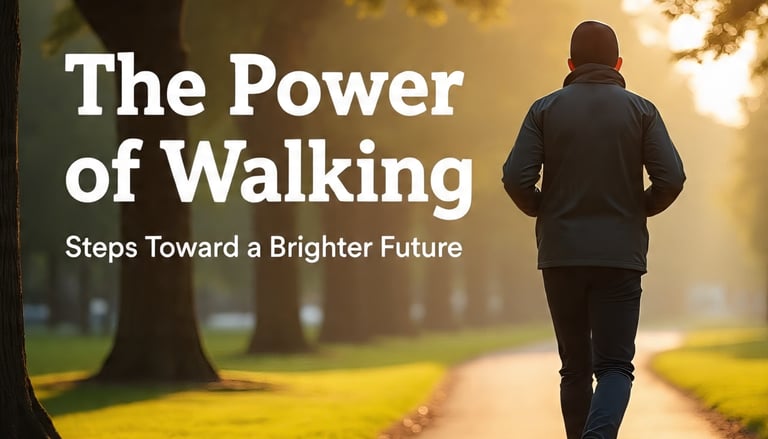The Power of Walking: Steps Toward a Brighter Future
Javed Niamat
9/1/20254 min read


Introduction: A Simple Step That Changes Everything
Imagine something so simple, so natural, that you have been doing it since childhood—yet it holds the power to heal your body, strengthen your mind, and brighten your future. That “something” is walking. Often overlooked in our fast-paced, technology-driven world, walking is one of the most underrated tools for improving physical health, boosting mental well-being, and creating a sustainable lifestyle. It requires no expensive gym membership, no fancy equipment, and no special training—just your two feet and the willingness to move.
In this article, we’ll explore the power of walking through the lens of science, personal well-being, and society as a whole. Walking isn’t just exercise—it’s a lifestyle choice that can transform the way we live today and how we step into tomorrow.
The Science Behind Walking: Why It Works
Walking is more than a leisurely activity; it is a scientifically proven way to improve health across multiple dimensions:
Heart Health: Research shows that walking at least 30 minutes a day can significantly reduce the risk of heart disease and stroke. It helps regulate blood pressure, lowers cholesterol, and improves circulation.
Weight Management: Walking may not burn calories as fast as running, but its long-term consistency makes it one of the most sustainable forms of weight control. Even brisk 20-minute walks daily can help prevent obesity.
Mental Health: Walking boosts endorphins—your brain’s natural mood enhancers. Studies show that walking in green spaces can reduce anxiety, ease symptoms of depression, and improve overall emotional balance.
Longevity: According to a study published in The British Journal of Sports Medicine, brisk walking is associated with a reduced risk of early death. In simple terms, walking helps us live longer.
Brain Power: Walking stimulates blood flow to the brain, sharpening memory, focus, and creativity. Many innovators, from Steve Jobs to Charles Dickens, used walking to spark their best ideas.
Walking and Mental Well-being: Healing the Mind One Step at a Time
In today’s world, mental health struggles such as stress, anxiety, and burnout have become increasingly common. Walking provides a natural therapy that requires no prescription:
Stress Relief: The rhythmic pace of walking helps calm the nervous system, reducing stress hormones like cortisol.
Mindfulness in Motion: Walking gives us the opportunity to practice mindfulness—focusing on our breath, surroundings, and inner thoughts.
Connection with Nature: Walking outdoors strengthens our bond with nature, which psychologists call “ecotherapy.” Just 20 minutes in a park can significantly boost happiness.
A brisk walk after a long day can clear mental fog, reset emotions, and restore balance in a way no screen or device ever can.
Walking as a Social Connector
Walking is not just a solitary act—it is a way to build community and relationships. Families that walk together spend quality time without distractions. Friends who catch up while walking often find conversations flow more naturally than when sitting indoors. In many cultures, walking meetings and “walk-and-talk” practices are replacing traditional boardroom discussions because movement fosters creativity and openness.
Neighborhoods where walking is common often report stronger social bonds, lower crime rates, and greater trust among residents. Simply put, walking connects people.
Environmental Impact: Walking Toward a Sustainable Future
Walking doesn’t just change our personal health—it changes the planet’s health too. Choosing to walk instead of drive:
Reduces carbon emissions
Cuts down on fuel consumption
Decreases traffic congestion
According to the U.S. Environmental Protection Agency, if everyone walked for short trips under one mile instead of driving, we could prevent millions of tons of carbon emissions annually. Walking is, therefore, one of the simplest and most effective ways to contribute to a greener future.
How to Make Walking a Daily Habit
The challenge isn’t knowing that walking is good—it’s making it part of daily life. Here are practical tips:
Start Small: Begin with 10 minutes a day, then gradually increase to 30 minutes or more.
Walk with Purpose: Use walking as transportation—for errands, commuting short distances, or school drop-offs.
Find a Buddy: Walking with a friend or family member adds motivation and accountability.
Make It Fun: Listen to music, podcasts, or audiobooks during your walk.
Mix It Up: Explore different routes, parks, or trails to keep walking exciting.
Walking as a Tool for Hope and Resilience
Beyond health, walking has a symbolic power—it represents movement, progress, and resilience. Survivors of illness, individuals recovering from loss, and people seeking clarity often describe walking as a path to healing. Each step, no matter how small, is a reminder that life continues forward.
Walking also teaches patience. Unlike instant results promised by quick-fix health trends, walking rewards consistency. Over time, the little steps compound into big changes. It is an empowering reminder that small, steady efforts can build a brighter, healthier future.
Conclusion: One Step at a Time Toward a Brighter Tomorrow
Walking is more than an exercise—it’s a gift. A gift to your body, mind, and spirit. A gift to your relationships, your community, and the environment. In a world often obsessed with speed and complexity, walking brings us back to simplicity. It reminds us that progress doesn’t always mean rushing—it can mean moving forward steadily, one step at a time.
So the next time you feel stuck, stressed, or overwhelmed, take a walk. With each step, you’re not just moving through space—you’re moving toward a brighter, healthier, and more hopeful future.